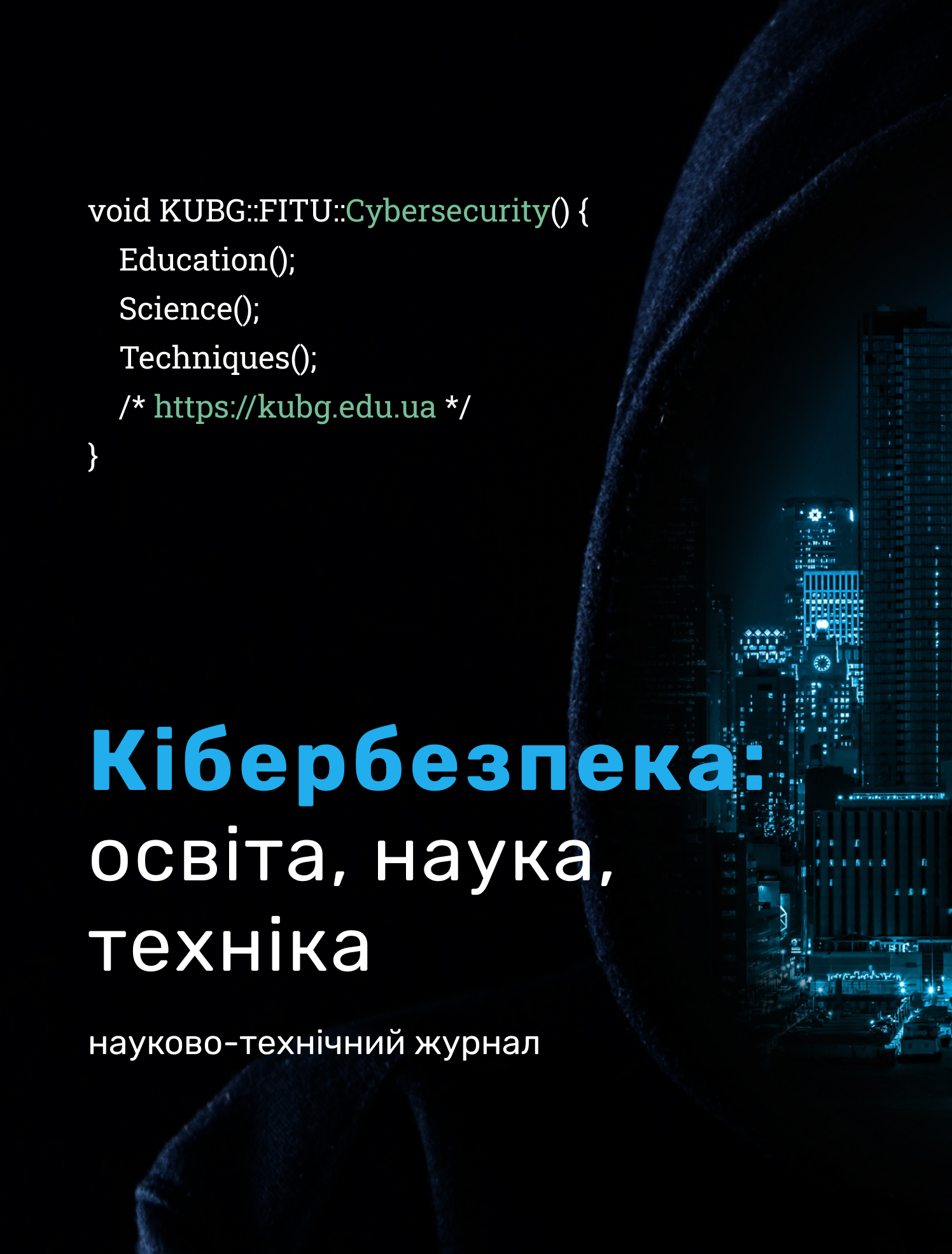ПСИХОЛОГІЧНІ МЕТОДИ ШАХРАЙСТВА В КІБЕРПРОСТОРІ ТА СПОСОБИ ЇМ ПРОТИДІЯТИ
DOI:
https://doi.org/10.28925/2663-4023.2025.30.990Ключові слова:
соціальна інженерія, психологічні маніпуляції, кібербезпека, фішинг, вішинг, інформаційна безпека, штучний інтелект, захист від шахрайства.Анотація
У статті досліджено методи соціальної інженерії, які використовуються зловмисниками для отримання несанкціонованого доступу до конфіденційної інформації та маніпулювання поведінкою жертв. Розглянуто основні види атак, такі як фішинг, вішинг, смішинг, прітекстинг, спір-фішинг і вейлінг, а також їхні особливості, механізми реалізації та способи обману користувачів. Особливу увагу приділено психологічним аспектам соціальної інженерії, включаючи вплив страху, довіри, терміновості, соціального доказу та когнітивних упереджень на процес прийняття рішень. Окреслено сучасні підходи до захисту від соціоінженерних атак, що включають поєднання технологічних та освітніх методів. Запропоновано заходи з підвищення цифрової грамотності користувачів, розробки політик інформаційної безпеки, застосування багатофакторної автентифікації, систем аналізу поведінки користувачів та штучного інтелекту для виявлення загроз. Особливу увагу приділено використанню великих мовних моделей для ідентифікації шахрайських схем та автоматизації кібербезпеки. Результати дослідження свідчать про необхідність комплексного підходу до захисту від атак соціальної інженерії, який передбачає синергію між технологічними інструментами та людським фактором. Запропоновані рекомендації спрямовані на мінімізацію ризиків та підвищення загального рівня безпеки в цифровому середовищі.
Завантаження
Посилання
Zaoui, M., Yousra, B., Yassine, S., Yassine, M., & Karim, O. (2024). A comprehensive taxonomy of social engineering attacks and defense mechanisms: Toward effective mitigation strategies. IEEE Access, 12, 72224–72241. https://doi.org/10.1109/ACCESS.2024.3403197
Mokhor, V. V., Tsurkan, O. V., Herasymov, R. P., & Tsurkan, V. V. (2017). Information security assessment of computer systems by socio-engineering approach. In Selected Papers of the XVII International Scientific and Practical Conference “Information Technologies and Security” (pp. 92–98). Kyiv.
Analysis of the cyber attack on the Ukrainian power grid. (2019).
Edwards, M., Larson, R., Green, B., Rashid, A., & Baron, A. (2017). Panning for gold: Automatically analyzing online social engineering attack surfaces. Computers & Security, 69, 18–34. https://doi.org/10.1016/j.cose.2017.05.003
Fathollahi-Fard, M. A., Hajiaghaei-Keshteli, M., & Tavakkoli-Moghaddam, R. (2018). The social engineering optimizer (SEO). Engineering Applications of Artificial Intelligence, 72, 267–293. https://doi.org/10.1016/j.engappai.2018.04.006
Mouton, F., Leenen, L., & Vente, H. (2016). Social engineering attack examples, templates and scenarios. Computers & Security, 59, 186–209. https://doi.org/10.1016/j.cose.2016.02.008
Engebretson, P. (2013). The basics of hacking and penetration testing. Elsevier.
Heartfield, R., & Loukas, G. (2018). Detecting semantic social engineering attacks with the weakest link: Implementation and empirical evaluation of a human-as-a-security-sensor framework. Computers & Security, 76, 101–127. https://doi.org/10.1016/j.cose.2018.02.010
Thomas, V. (2014). Building an information security awareness program. Elsevier.
Ghafir, I., Prenosil, V., Alhejailan, A., & Hammoudeh, M. (2016). Social engineering attack strategies and defense approaches. In Proceedings of the IEEE 4th International Conference on Future Internet of Things and Cloud (pp. 145–149). Vienna, Austria. https://doi.org/10.1109/FiCloud.2016.27
Mitnick Security. (2022). The top 5 most famous social engineering attacks of the last decade. https://www.mitnicksecurity.com/blog/the-top-5-most-famous-social-engineering-attacks-of-the-last-decade
Infosec Institute. (n.d.). The top ten most famous social engineering attacks. https://www.infosecinstitute.com/resources/security-awareness/the-top-ten-most-famous-social-engineering-attacks
PhoenixNAP. (n.d.). Examples of social engineering attacks. https://phoenixnap.com/blog/social-engineering-examples
Krombholz, K., Hobel, H., Huber, M., & Weippl, E. (2014). Advanced social engineering attacks. Journal of Information Security and Applications, 19(3), 183–194. https://doi.org/10.1016/j.jisa.2014.09.005
Marchenko, O. I. (2021). Data processing algorithms for cybersecurity. Vinnytsia: VNTU.
Lytvynenko, V. A. (2023). Use of artificial intelligence in information security. Kyiv: NASU Publishing House.
World Economic Forum. (2024, February). Deepfake scam: Employee tricked into transferring $25 million during video call. https://www.weforum.org/stories/2025/02/deepfake-ai-cybercrime-arup
Sydorenko, I. G. (2021). Psychology of social engineering: Mechanisms and protection. Kharkiv: Kharkiv University.
Pashko, V. K. (2022). Information technologies: Fundamentals and applications. Ternopil: TNTU.
Bily, A. S. (2020). Information protection in computer networks. Zaporizhzhia: ZNU.
Kolesnyk, D. O. (2021). Cybersecurity in the context of digital transformation. Lutsk: LNTU.
Shevchenko, R. P. (2022). Modeling information security threats. Sumy: SumDU.
Stetsenko, N. G. (2020). Information culture and cybersecurity. Kherson: KhDU.
Golub, O. V. (2023). Integration of large language models into security systems. Mykolaiv: MNU.
Trellix. (2023). Trellix 2024 threat predictions. https://www.trellix.com/about/newsroom/stories/research/trellix-2024-threat-predictions
Tripathi, S. (2023). Underground development of malicious LLMs. https://www.trellix.com/about/newsroom/stories/research/trellix-2024-threat-predictions
Ajeeth, S. (2023). The resurrection of script kiddies. https://www.trellix.com/about/newsroom/stories/research/trellix-2024-threat-predictions
Опубліковано
Як цитувати
Номер
Розділ
Ліцензія
Авторське право (c) 2025 Олег Гарасимчук, Юлія Оліярник, Андрій Нестор, Тарас Наконечний

Ця робота ліцензується відповідно до Creative Commons Attribution-NonCommercial-ShareAlike 4.0 International License.




